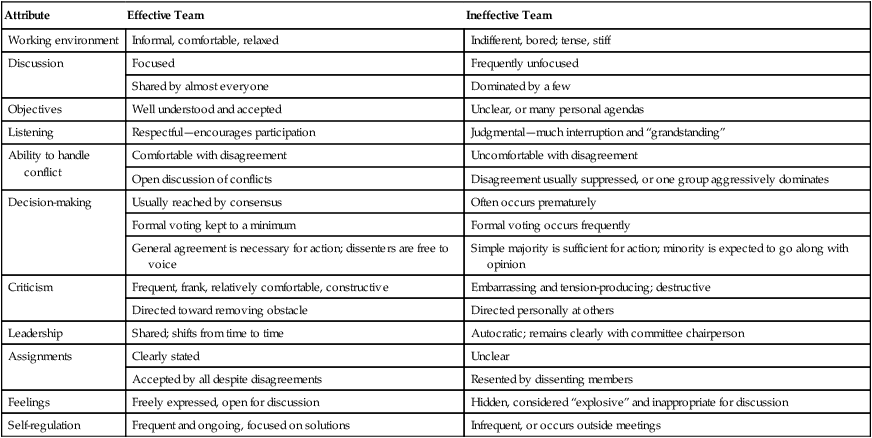1. Discuss nurse leader responsibility regarding group management. 2. Review techniques for working with groups. 3. Review techniques for leading groups and meetings. 4. Differentiate between functional and dysfunctional groups. 5. Review the different methods used to evaluate staff performance. 6. Identify the difference between supervising and evaluating the work of others. 7. Review the importance of supervising and leading groups, task forces, and patient care conferences. A group consists of individuals who interact and influence each other. Groups exist in organizations. Group members include (Sullivan & Decker, 2005, p. 157): • Individuals from a single work group or individuals at similar job levels from more than one work group • Individuals from different job levels • Individuals from different work groups and different job levels in the organization • Interdisciplinary teams—Sometimes called collaboratives, which are composed of the different functions caring for a patient. An example would be an ambulatory chemotherapy collaborative, in which the team composition includes the nurse, the pharmacist, the dietician, the admission clerk, and the intravenous therapist. • Patient care team—This may be similar to the group of individuals actually providing actual care to the patient. It may be composed of all individuals responsible for care per shift or over 24 hours. • Performance improvement team—May include individuals from various disciplines and from various levels of the organization (e.g., department head, staff nurse, environmental services member, etc.) The nurse and nurse manager are also part of a much larger group—the patient care (or nursing) department. As a member of this larger group, it is important to support the overall goals of the patient care department and be a functional valued member of this team. The characteristics of your team will depend on the characteristics of the group (Box 20-1). Teams are real groups in which individuals must work cooperatively with each other to achieve some overarching goal (Sullivan & Decker, 2005, p. 157). The first rule for dealing with individuals as well as with teams is to be a good listener. As a good listener, you must listen actively. When a person listens actively, the person is completely focused and tuned in to the individual who is speaking. The active listener is nonjudgmental and comprehends the full conversation. See Box 20-2 for guidelines for active listening. Nurse managers are often asked to lead group or team meetings. Many of these meetings may be staff meetings for review of issues of importance to the unit, performance improvement teams, or patient care teams. Some guidelines for leading group meetings follow (Sullivan & Decker, 2005, p. 168): Parker (1990) states that a team is a group of people with a high degree of interdependence geared toward the achievement of a goal or a task. Not all teams function well, and there are times when even the most qualified team has a dysfunctional day. If a team has a “bad day,” it is important for the team member or leader to evaluate the reasons for the poor performance. If the reasons can be understood, it will be important to alter the way the team works to increase functionality, efficiency, and patient outcomes. When a team functions effectively, a significant difference is evident in the entire work atmosphere the way in which discussions progress, the level of understanding of the team-specific goals and tasks, the willingness of members to listen, the manner in which disagreements are handled, the use of consensus, and the way in which feedback is given and received (Yoder-Wise, 2003, p. 343). The original work done by McGregor (1960) shows significant differences between effective and ineffective teams (Table 20-1). Table 20-1 ATTRIBUTES OF EFFECTIVE AND INEFFECTIVE TEAMS Modified from McGregor, D. (1960). The human side of enterprise. New York: McGraw-Hill. Combine your scores for the preceding statements as indicated below:
Supervising and Evaluating the Work of Others
GROUPS AND TEAMS
ACTIVE LISTENING
CONDUCTING MEETINGS
EFFECTIVE AND INEFFECTIVE TEAMS
Attribute
Effective Team
Ineffective Team
Working environment
Informal, comfortable, relaxed
Indifferent, bored; tense, stiff
Discussion
Focused
Frequently unfocused
Shared by almost everyone
Dominated by a few
Objectives
Well understood and accepted
Unclear, or many personal agendas
Listening
Respectful—encourages participation
Judgmental—much interruption and “grandstanding”
Ability to handle conflict
Comfortable with disagreement
Uncomfortable with disagreement
Open discussion of conflicts
Disagreement usually suppressed, or one group aggressively dominates
Decision-making
Usually reached by consensus
Often occurs prematurely
Formal voting kept to a minimum
Formal voting occurs frequently
General agreement is necessary for action; dissenters are free to voice
Simple majority is sufficient for action; minority is expected to go along with opinion
Criticism
Frequent, frank, relatively comfortable, constructive
Embarrassing and tension-producing; destructive
Directed toward removing obstacle
Directed personally at others
Leadership
Shared; shifts from time to time
Autocratic; remains clearly with committee chairperson
Assignments
Clearly stated
Unclear
Accepted by all despite disagreements
Resented by dissenting members
Feelings
Freely expressed, open for discussion
Hidden, considered “explosive” and inappropriate for discussion
Self-regulation
Frequent and ongoing, focused on solutions
Infrequent, or occurs outside meetings

TEAM ASSESSMENT QUESTIONNAIRE
Scoring
Dysfunction 1: Absence of Trust
Dysfunction 2: Fear of Conflict
Dysfunction 3: Lack of Commitment
Dysfunction 4: Avoidance of Accountability
Dysfunction 5: Inattention to Results
Statement 4: ___
Statement 1 : ___
Statement 3: ___
Statement 2: ___
Statement 5: ___
Statement 6: ___
Statement 7: ___
Statement 8: ___
Statement 11: ___
Statement 9: ___
Statement 12: ___
Statement 10: ___
Statement 13: ___
Statement 14: ___
Statement 15: ___
Total: ___
Total: ___
Total: ___
Total: ___
Total: ___ ![]()
Stay updated, free articles. Join our Telegram channel

Full access? Get Clinical Tree


Supervising and Evaluating the Work of Others
Get Clinical Tree app for offline access


